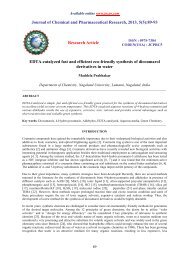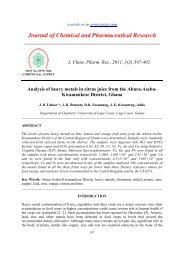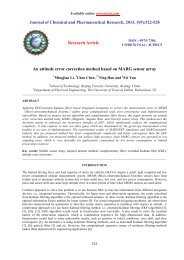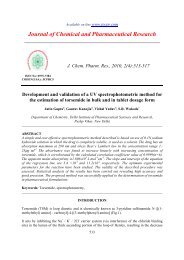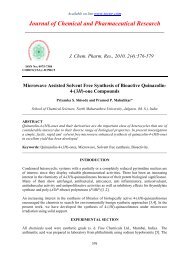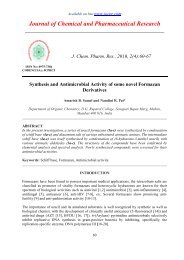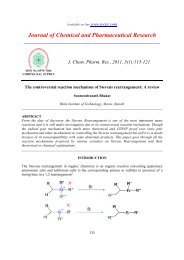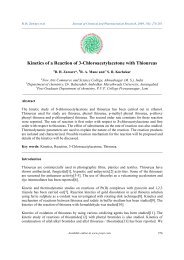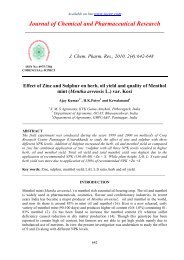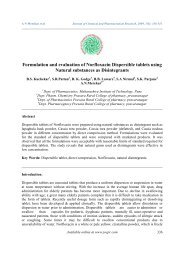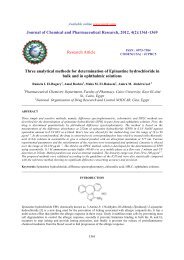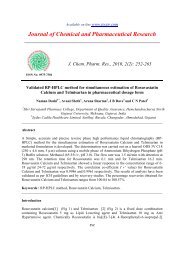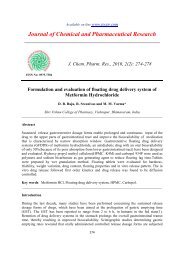antimicrobial activity of thiosemicarbazone derivatives of Lawsone
antimicrobial activity of thiosemicarbazone derivatives of Lawsone
antimicrobial activity of thiosemicarbazone derivatives of Lawsone
- No tags were found...
Create successful ePaper yourself
Turn your PDF publications into a flip-book with our unique Google optimized e-Paper software.
Available on line www.jocpr.comJournal <strong>of</strong> Chemical and Pharmaceutical Research__________________________________________________ISSN No: 0975-7384CODEN(USA): JCPRC5J. Chem. Pharm. Res., 2010, 2(4):106-111Antimicrobial Activity Of Thiosemicarbazone Derivatives Of<strong>Lawsone</strong> And Its Nickel Complexes*Sanjay Gaikwad and Charushila GaikwadDepartment <strong>of</strong> Chemistry, Post-graduate and Research Centre,Bharatiya Jain Sanghatana College, Wagholi,.Pune, India______________________________________________________________________________ABSTRACTThiosemicarbazone derivative at 1 and 2 position <strong>of</strong> the Biologically important <strong>Lawsone</strong> ( 2-hydroxy-1,4-naphthalenedione ) have been synthesized. This possesses a powerful chelatingability, appreciable analytical utility and significant biological <strong>activity</strong>. Metal complexes <strong>of</strong>TSCND with Ni(II) metal have been synthesized and studied with the help <strong>of</strong> spectral analysisand elemental analysis. The <strong>antimicrobial</strong> <strong>activity</strong> <strong>of</strong> the ligands and their metal complexesagainst bacteria and fungus has been carried out. It is found that the metal complexes havehigher activities than those <strong>of</strong> free ligands.Keywords: <strong>Lawsone</strong>, Thiosemicarbazone derivative, Nickel (II) complex and microbial Studies______________________________________________________________________________INTRODUCTIONNaturally occurring quinones have several different roles in organisms, they are functionalconstituents <strong>of</strong> several biochemical systems ( e.g. ubiquinones and vitamin K 1 ), they are dyes orthey act as defensive compounds. Quinines are used as pharmaceuticals. The exposure <strong>of</strong> cell toquinonidal compounds may lead to several deleterious consequences. Chronic exposure toquinones may be carcinogenic; several quinones are mutagenic in the Ames test as well as tocultures <strong>of</strong> eukaryotic cells. Acute exposure to quinones may cause cell death. Severalanticancer drugs contain the quinone part ( figure 1) and adramycin, a synthetic quinone is usefulin cancer chemotherapy .106
Sanjay Gaikwad et al J. Chem. Pharm. Res., 2010, 2(4): 106-111_____________________________________________________________________________OHOOHOH 3 CClOH 3 COHFigure 1. 1,4-naphthaquinones as a partOQuinone compounds are known for their antibacterial <strong>activity</strong>. This peculiarity is well exhibitedin the compounds <strong>of</strong> our interest i.e. 1,4-naphthoquinones, which are vitamin K 3 analogs ( figure2 ).OOHRO(a). Vitamin K 3 (b). 1-TSCND ( L1)(c) . 2-TSCND ( L2)(d) . 3-chloro-2-TSCND ( L3Figure 2. Vitamin K 3In our laboratory, several <strong>derivatives</strong> <strong>of</strong> hydroxyl- naphthalenediones and their metal complexeshave been studied, particularly with their <strong>antimicrobial</strong> and antifungal <strong>activity</strong>. The complexeswith sulpher, nitrogen and oxygen impart special biological <strong>activity</strong> [1-4], particularly<strong>thiosemicarbazone</strong> <strong>derivatives</strong> [5-9]. The inhibitory action <strong>of</strong> these compounds is given to theirchelating properties [10-16]. In the present work the <strong>antimicrobial</strong> study <strong>of</strong> <strong>thiosemicarbazone</strong>derivative <strong>of</strong> <strong>Lawsone</strong> [17] and its complexes with Ni(II), where the change <strong>of</strong> ligating systemfrom O O , O N to O N S. is studied.The <strong>antimicrobial</strong> <strong>activity</strong> study <strong>of</strong> all the compounds can be studied from followingmicroorganisms.107
Sanjay Gaikwad et al J. Chem. Pharm. Res., 2010, 2(4): 106-111_____________________________________________________________________________BacteriaGram Positive BacteriaGram Negative BacteriaFungal StrainFungal StrainMicroorganismsBacillus Substilis, S. AureusEscherichia ColiAspergillus NigerPenicillinMediaNutrient Agar :-It is prepared by weighing exactly 28.0 gm <strong>of</strong> Neutrient Agar, which is purchased fromHIMEDRA and get dissolved to 1000 ml <strong>of</strong> distilled water. The pH <strong>of</strong> the solution is adjusted to7.0 with the help <strong>of</strong> dil. HCl or NaOH solution. Then the solution is heated to boil. After boilingthis solution, it is sterilize by using Autoclave at 121 o C for ca. 20 min.Nutrient Broth :-It is prepared by weighing separately (10.0 gm <strong>of</strong> Beef extract, 10.0 gm <strong>of</strong> Peptone and 5.0 gm <strong>of</strong>Sodium Chloride) ingredients and dissolving to 1000 ml <strong>of</strong> distilled water. The pH <strong>of</strong> thesolution is adjusted to 7.0 with the help <strong>of</strong> dil. HCl or NaOH solution. . Then the solution isheated to boil. After boiling this solution, it is sterilize by using Autoclave at 121 o C for ca. 20min.The stock culture <strong>of</strong> these microorganisms were maintained ay 20 o C in 15% glycerol. Theinoculums were prepared from stock culture by streaking into the plate count agar for bacteriaand on Sabrourauds dextrose agar for fungi. After an overnight incubation single colony wasused to inoculate sterile liquid media. The 5 ml broth was dispensed in test tube and sterilized inthe autoclave at 120 o C for 15 min. The broths were then inoculated with respective culture andincubated on an orbital shaker ( 150 rpm ) overnight at 30 o CWell Diffusion MethodThe wells <strong>of</strong> 5 mm diameter were made in the agar set in Petri dish previously spread with 50 µl<strong>of</strong> test compounds. The plates were pre-incubated for 2 hours at 4 o C and then incubated for 18hours at 37 o C. For Aspergillus Niger, the incubation was done for 72 hours at room temperature.The zone <strong>of</strong> inhibition was then measured. The control experiments were performed usingequivalent volume <strong>of</strong> the solvent itself loaded in to the wells. All the values <strong>of</strong> inhibition zoneare average <strong>of</strong> three replicate experiments. The standard deviation <strong>of</strong> all values was within 5 %<strong>of</strong> arithmetic mean.RESULTS AND DISCUSSIONSThe <strong>antimicrobial</strong> <strong>activity</strong> <strong>of</strong> <strong>thiosemicarbazone</strong> <strong>derivatives</strong> <strong>of</strong> <strong>Lawsone</strong> at 1 and 2 position andtheir Nickel (II) complexes with 1:1 and 1:2 ratio were evaluated againstBacteriaGram Positive BacteriaGram Negative BacteriaFungal StrainMicroorganismsS. AureusEscherichia ColiPenicillinDichlone was used as a standard, while DMF, Nickel (II) acetate were used as control. Somerepresentative photographs showing inhibition zones.108
Sanjay Gaikwad et al J. Chem. Pharm. Res., 2010, 2(4): 106-111_____________________________________________________________________________The ligand <strong>thiosemicarbazone</strong> <strong>derivatives</strong> synthesized for present work shows the <strong>activity</strong>against all the bacteria and fungi strains studied. This observation tend to suggest that the<strong>thiosemicarbazone</strong> derivative at 2 position (L2 and L3 ) shows more prone for binding withtarget molecules <strong>of</strong> organisms thus retarding the growth. Another reason may be intermolecularhydrogen bonding probably promoting the proper binding with growth promoting biomolecules.The ligand (L1) and their Ni complex show very law <strong>activity</strong>.Compounds:1. 1-TSCND (L1), 2. 2-TSCND ( L2). 3. 3-Cl-2-TSCND (L3)4. <strong>Lawsone</strong>, 5. Dichlone 6. Ni(II) complex with 1-TSCND [ M L 1 ]Ac7 Ni(II) complex with 1-TSCND [M(L 1 ) 2 ]8. Ni(II) complex with 2-TSCND [ML 2 ]Ac9. Ni(II) complex with 2-TSCND [M(L 2 ) 210. Ni(II) complex with 3-Cl-2-TSCND [ML 3 ]Ac11. Ni(II) complex with 3-Cl-2-TSCND [M(L 3 ) 2 ]Microorganisms1. Gram +ve A-SA, B-SA, C-SA and D-SA2. Gram -ve A-EC, B-EC, C-EC and D-EC3. Fungal A-F, B-F, C-F and D-FThe compounds were kept in the medium as A, B, C and D for the comparison. The observedzones are as given in photographs.1. 2. 3. 4.Figure 5.2. Fungal Strain - Penicillin1. 2. 3. 4.Figure 5.3. Against Gram Positive Bacteria - S. Aureus109
Sanjay Gaikwad et al J. Chem. Pharm. Res., 2010, 2(4): 106-111_____________________________________________________________________________1. 2. 3. 4.Table 5.2 Inhibition zones measured after 24 hoursSr. No.CompoundAntibacterialGram +ve Gram –veAntifungal1 1-TSCND 6 08 122 2-TSCND 20 12 203 3-Cl-2-TSCND 10 09 154 <strong>Lawsone</strong> 08 06 125 Dichlone 08 10 156 Ni(1-TSCND)Ac 07 09 127 Ni(1-TSCND)2 06 08 108 Ni(2-TSCND)Ac 15 12 189 Ni(2-TSCND)2 08 09 1810 Ni(3-Cl-2-TSCND)Ac 10 15 1511 Ni(3-Cl-2-TSCND)2 09 12 2012 DMF ( control) 06 06 0613 Ni(II) acetate 06 06 06AcknowledgementThe author thanks to BCUD, Pune University and UGC for providing financial support.REFERENCES[1] RH. Holm, GW. Evereft and A. Chakravorty, ‘Progress in Inorganic Chemistry’ Vol. 7, P 83,edited by F. Ablest Cotton.[2] BJ. Hathway, G. Wilkinson, RD. Gillard and JA. MC Cleverty, ‘ComprehensiveCoordination Chemistry’ Pergamon, Oxford, 1987, Vol 5, 533[3] R. Shkru, N. J. P. Subhashini, Satish kumar and K. Shivraj, J. Chem. Phrm. Res., 2010 2(1)38-46[4] Y. Subba Rao, B. Pratima, O. Hariprasad, N. Nagabhushan Reddy, M. Jagdeesh and A.Varada Reddy, J. Chem. Pharm. Res., 2010 2(1) 292-299110
Sanjay Gaikwad et al J. Chem. Pharm. Res., 2010, 2(4): 106-111_____________________________________________________________________________[5] R. Tudor, G. Aurelian, N. Anca, G. Rodica, Molecules., 2007 12(4) 782-796[6] C. Suresh and T. Monica, J. Serb. Chem. Soc., 2008 (73) 727-734[7] DX West, SB. Padhye and PB. Sonawane, Structure. Bonding, 1991 76(4) 11-22[8] Z. Afrasiabi, E. Sinn and SB. Padhye, J. Inorg. Biochem., 2003, 95(4) 306-314[9] CK. Nariko, S. Kiyoshi, K. Chisa, S. Nobuhiro, I. Motoki and N. Kenji, J. Inorg. Biochem.,2001, 84(1-2) 55-56[10] NK. Sing and SB. Sing, Indian J. Chemistry., 2001, 40(10) 1070 – 1075[11] SB. Padhye and BA. Kulkarni, J. Magn. Reson., 28, 154 ( 1986)[12] S. Padhye, R. Chikate, A. Kumbhar, J. shalom and M. Chitnis, Biometals,5, 67 (1992)[13] VD. Kelkar, BA. Kulkarni and PT. Kulkarni, Ind. J. Pharma. Sci.., 55 21 (1993)[14] Z. Afrasiabi, and E. Sinn, J. Chem., Inorg. Chim. Acta., 2004, 357(1), 271 – 278[15] E. Labsbal, KD. Haslow, A. Sousa-Pedrares, J Valdes-Mart’inez, S. Hernandez-Ortega andd. X. West, Polyhedron, 2003, 22(20) 2831 - 2837[16] DK. Ajay Kumar, AP. Sangamesh and SB. Prema, Int. J. Electrochem. Sci., 2009, 4, 717 -729[17] Sanjay Gaikwad, Charushila Gaikwad, Sandip Khansole and Rajendra Kankariya, Bull.Pure. Appl. Sci., 2010, Vol 29C (1) 1-8111



